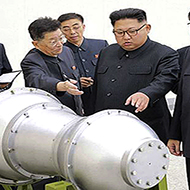Hydrogen bomb in NKorea’s biggest nuclear test yet

North Korea celebrated its sixth and most powerful nuclear test Sunday, boasting it had launched a hydrogen bomb outfitted for intercontinental ballistic missiles. The US Geological Survey recorded a 6.3 magnitude earth tremor, felt and confirmed in Seoul and China, from North Korea’s test side in Punggye-ri in the northeast region. It was manmade and attributed to this test, which seismic experts with Norway’s Norsar believe had an explosive yield of about 120 kilotons.
The Vienna-based Comprehensive Nuclear-Test-Ban Treaty said the test is evidence that North Korea's nuclear program is “advancing rapidly.”
Seismologists also noted a second tremor of a 4.1 magnitude, which occurred at the same location minutes after the first one and they categorized as a “collapse.”
As tensions around the peninsula ratcheted up further, US National Security Adviser H.R. McMaster addressed the test in an emergency phone call with his South Korean counterpart, Chung Eui-yong, for about 20 minutes after the detonation.
No response was forthcoming from the White House or the State Department.
The North Korean leader Kim Jng-un inspected the new H-bomb at his nation’s Nuclear Weapons Institute, according to a Sunday statement from the state-run Korean News Agency. The bomb was portrayed as part of North Korea’s stated program to build a nuclear arsenal capable of reaching the U.S. mainland.
In July, North Korea conducted a pair of ICBM tests for the first time.
Weeks after a North Korean ballistic missile flew over Japanese air space, Prime Minister Shinzo Abe issued a statement on Sunday saying “If North Korea has indeed gone ahead with a nuclear test, it is completely unacceptable and we must lodge a strong protest.”


